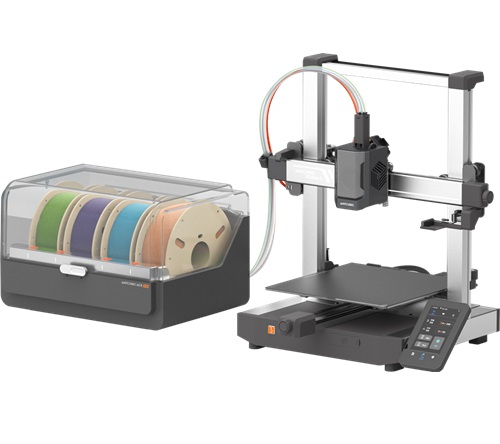Compare Photon M3 Premium vs Kobra 3 Combo
Comparison between the best 3D printers
Choose the best 3D printer at the best price. The cheapest 3D printers are here.
Buy a 3D printer here with 3D Fila.
 |
 |
|
| Model | Photon M3 Premium[BUY Photon M3 Premium] |
Kobra 3 Combo[BUY Kobra 3 Combo] |
| Printing Material | Resin | Filament |
| Buy Resin for Anycubic Photon M3 Premium | Buy Filament forAnycubic Kobra 3 Combo | |
| Estimated price | $600,00 | $349,00 |
| Manufacturer | Anycubic | Anycubic |
| Release Year | 2022 | 2024 |
| Print Volume [mm] | 123x219x250 | 250x250x260 |
| Printer Size [mm] | 330x350x630 | 452x504x483 |
| Weight [kg] | 19 | 9,2 |
| Power Loss Recovery | NO | YES |
| Maximum Resolution [mm] | 0,01 | 0,1 |
| Processor | 32 bits | |
| Display | Display touchscreen 4,3'' | Touchscreen 4,3'' |
| Power Supply | 150 W | 400 W |
| Connectivity | USB / Wi-Fi | USB, Wi-Fi, Cloud |
| Operating systems | Windows, Linux, Macbook | |
| Date of registration in the system | 2023-01-19 | 2024-06-27 |
| Release date | 2022 | 2024 |
| Extra features | The Anycubic Photon M3 Premium Printer features MSLA technology with a 10-inch monochrome LCD screen and 8K resolution, ensuring prints with fine details thanks to the 28.5 micron resolution. It has a generous build volume (219 x 123 x 250 mm), an intelligent cooling system for greater durability, and a laser-etched build plate for better adhesion. It offers dual air filters, reducing odors, and the promise of compatibility with the Anycubic Cloud app. Its design includes an Art Deco-style UV curved glass and an efficient leveling system for the build platform. | The Anycubic Kobra 3 Combo offers advanced features, including multi-filament printing with the ACE (Anycubic Color Engine) system, allowing for quick switching of up to four filaments. It features automatic bed leveling, nozzle clogging detection, and integrated filament drying during printing. The printer supports technical materials such as ABS, ASA, Nylon, and PC, thanks to the hotend that reaches 300°C and the heated bed up to 110°C. In addition, it has a 4.3-inch touchscreen and compatibility with various slicers such as Anycubic Slicer, Cura, and Orca Slicer. |
| Support for multiple colors and materials (AMS and CFS) | NO | YES |
Notes * |
||
| Cost-benefit | 7 / 10 | 8 / 10 |
| Hardware | 3 / 10 | 4 / 10 |
| Tela | . | . |
| Print volume | 3 / 10 | 4 / 10 |
| Performance | 9 / 10 | 5 / 10 |
| [BUY Photon M3 Premium] | [BUY Kobra 3 Combo] |
Conclusion |
| In conclusion, the comparison between the Anycubic Photon M3 Premium and the Anycubic Kobra 3 Combo highlights the strengths and considerations of each printer, allowing potential buyers to choose based on their specific needs and budget. The Photon M3 Premium excels in delivering high-resolution prints with advanced MSLA technology, making it ideal for users focused on fine detailing, especially in applications like jewelry design or miniatures. Its build volume is somewhat limited compared to the Kobra 3 Combo, and it lacks features like power loss recovery and multi-material compatibility, which may pose challenges for users looking for versatility in larger projects. On the other hand, the Kobra 3 Combo acknowledges modern printing needs with its multi-filament capabilities, making it suitable for users interested in using a variety of materials. Features such as automatic bed leveling and built-in filament drying enhance its usability and efficiency, particularly for those who prioritize reliability in prints. However, it has a slightly lower resolution compared to the M3 Premium, making it less ideal for highly detailed work. Price-wise, while the Photon M3 Premium comes at a higher cost, it offers specialized features for high-detail prints, while the Kobra 3 Combo provides excellent value with versatile capabilities at a more affordable price. Depending on the user's priorities — whether it be detailed resin prints or the flexibility of multi-material filament printing — each option presents a compelling case for its respective user base. Ultimately, both printers cater to different preferences, and the best choice will depend on the specific requirements of the potential user. |

